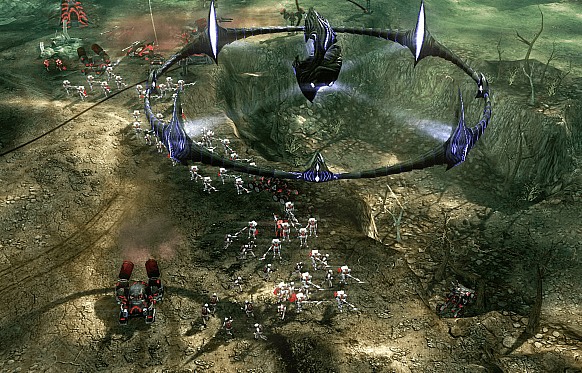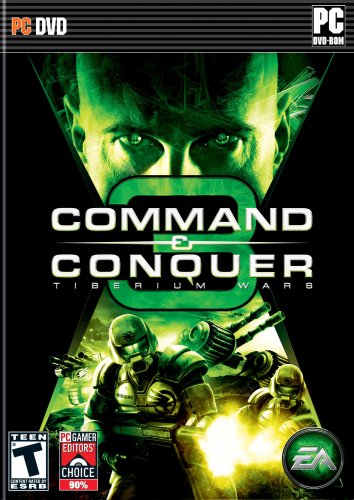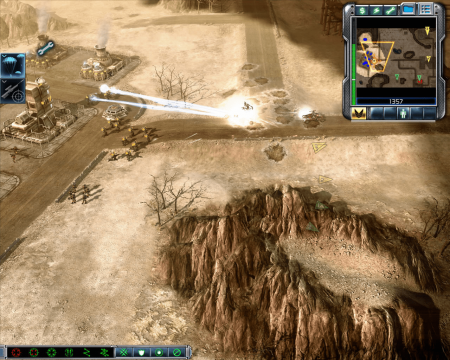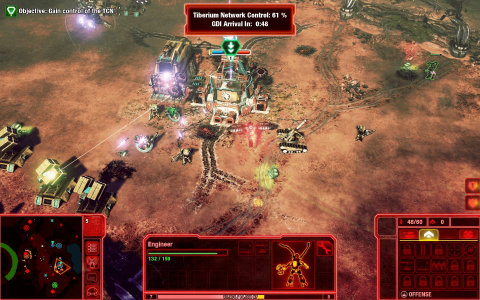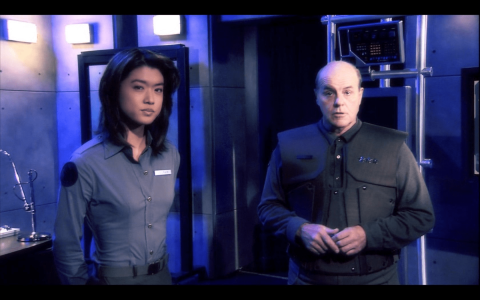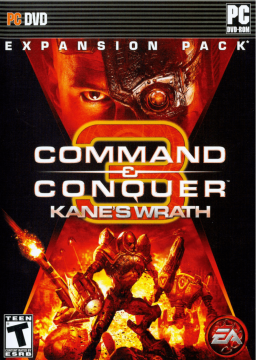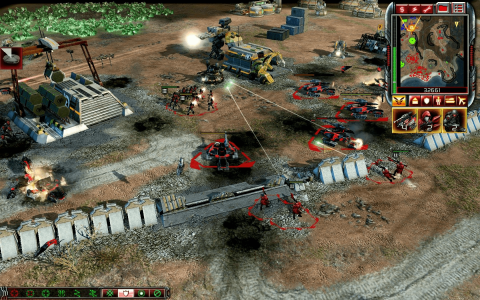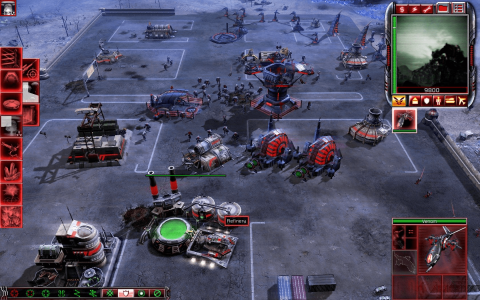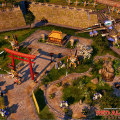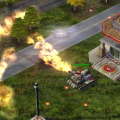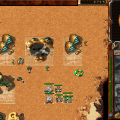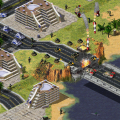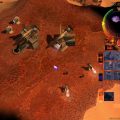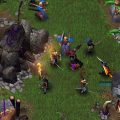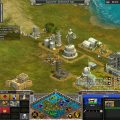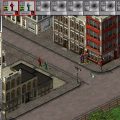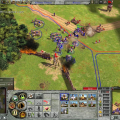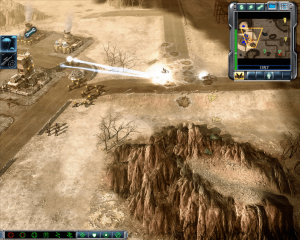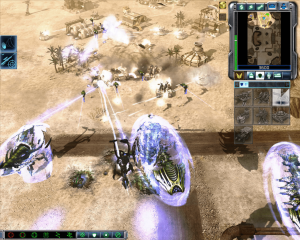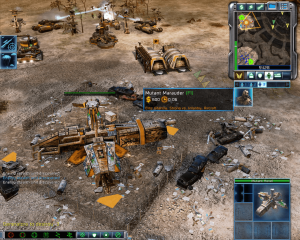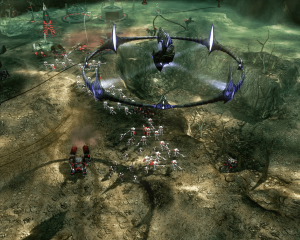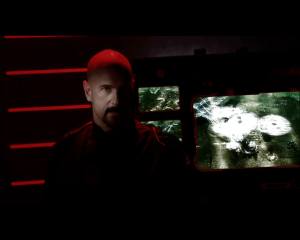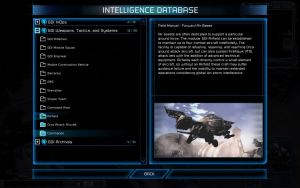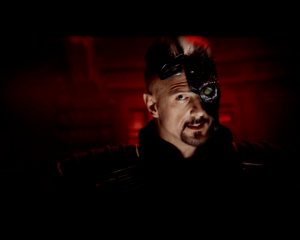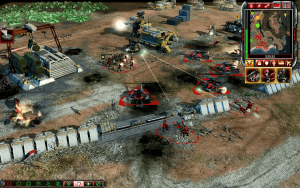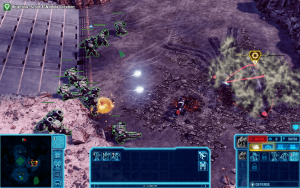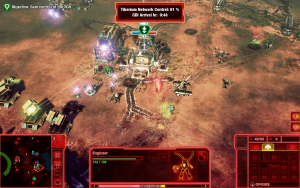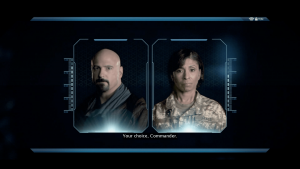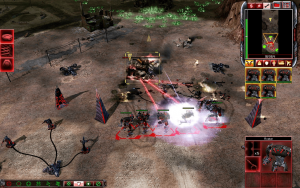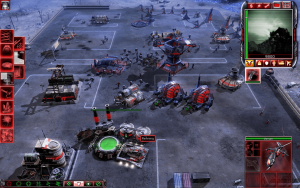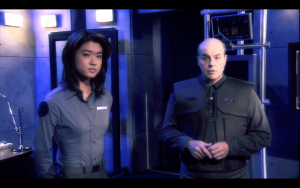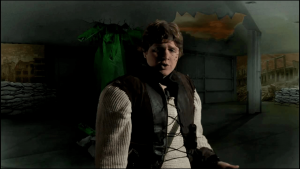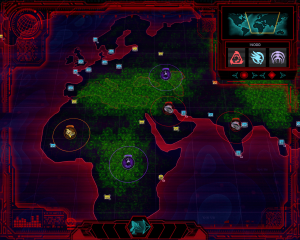- Command and Conquer
- Command and Conquer: Red Alert
- Command and Conquer: Tiberian Sun
- Command and Conquer: Renegade
- Command and Conquer: Red Alert 2
- Command and Conquer Generals
- Command and Conquer 3: Tiberium Wars
- Command and Conquer: Red Alert 3
- Command and Conquer 4: Tiberian Twilight
- Command & Conquer: Generals: Combat Cards
- Command & Conquer 3: Tiberium Wars (Mobile)
- Command & Conquer: Red Alert Mobile
- Command & Conquer: Red Alert (iOS)
- Command & Conquer 4: Tiberian Twilight (Mobile)
- Command & Conquer: Tiberium Alliances
- Red Alert OL
C&C lives in death.
The Command and Conquer franchise has been such a long-running presence in real-time strategy that its various games and offshoots comprise three distinct continuities. Of these (which include the campier alternate history of the Red Alert games and the grittiness of Generals) the original that began with the first title in 1995 (since retconned as Tiberian Dawn) still holds a place of honor among fans. Notably serious and grim, with a combination of sci-fi action and esoteric mystery, the Tiberium timeline helped popularize the notion of RTS, introduced FMV cutscenes and deeper plots, and introduced Kane, one of the most infamous yet memorable characters in PC gaming. With that honor, however, come high expectations, especially in the wake of Westwood Studios’ closure in January 2003. Any continuation or follow-up would thus be seen as a daunting challenge. One that EA Los Angeles took head-on.
Although a proper sequel to Tiberian Sun had been anticipated since 1999, it wasn’t until April 2006 (as well as the success of Generals and Zero Hour) that Command & Conquer 3: Tiberium Wars was officially announced. By then, it had become common knowledge among fans of the series in particular that Westwood was working on a third entry in the Tiberium universe before its demise; under the working title Tiberian Twilight (also known as Incursion), there was even a 3D tech demo made. The material left behind, however, would inspire and influence EALA’s efforts, even while trying to add fresh touches on the saga befitting the 21st Century. The resulting game, which came out on March 2007, was met with accolades across the board from game journalists and RTS aficionados alike. Reception among long-time fans at the time, however, tended to be more divided given the pedigree. Inevitably, comparisons were made with earlier works (especially those by the now-defunct studio), with more than a few debates springing up on whether the final product’s what the original developers intended for the series. This is to say nothing of the changing tides in strategy gaming that manifested at the time, be it through games like World in Conflict released that same year or the emergence of MOBAs as a popular alternative. And though it wasn’t perceived as a “black sheep” in the same way as Generals was at the time, it seemed as though the game would be forever in the shadow of its predecessors.
Yet over a decade on, Tiberium Wars has defied such cynical sentiments. Be it for the lore, atmosphere, graphics and/or solid gameplay, much like Generals it’s taken a life of its own, with active servers and even a healthy modding community. If anything, the game – much like the universe it’s part of – continues to endure among long-time fans and more casual gamers alike, a bridge between old and new. At the same time, however, especially since the release of the actual Tiberian Twilight, it’s since come to hold a bittersweet place among fans, symbolizing a wasted potential for what the franchise’s future could have been. Even without the nigh-inevitable comparisons with that ignoble chapter, one has to wonder just how this game manages to for the most part stay true to its heritage while being a solid rump in its own right.
Command and Conquer 3: Tiberium Wars fast-forwards to 2047, over 15 years from the events of Tiberian Sun and Firestorm. More than half a century has passed since the alien substance called Tiberium first arrived on Earth, changing the course of human history – and the planet itself – forever. A ravaged world is now more or less split into Blue Zones (nigh-pristine regions and enclaves of civilization), Yellow Zones (vast, Tiberium-infested wastelands where the majority of humanity live and struggle to survive) and Red Zones (uninhabitable hellscapes warped by Tiberium). The Global Defense Initiative, complacent from the seeming defeat of the insidious Brotherhood of Nod, continues to uphold an uneasy peace and find a way to contain the deadly, yet miraculously vital resource. Any sense of calm is soon shattered, however as Nod stages a surprise attack on GDI’s leadership. All signs point to a man who shouldn’t even be alive: the Brotherhood’s enigmatic leader, known only as Kane. All the while, hidden in the stars an extraterrestrial force is woken from its slumber far ahead of schedule. Thus, begins the Third Tiberium War, in which humanity fate is on the line and the truth about the substance begins to reveal itself.
Although the Tiberium universe (being the one that started it all) arguably the most developed if extensive of the three Command and Conquer continuities, it’s nonetheless accessible enough that newcomers wouldn’t find much difficulty in getting up to speed; that Tiberium itself is both the vital resource in-game and a major aspect of the setting helps considerably in that regard. In addition, EALA makes a considerable effort to not simply rehash what Westwood left behind, but further expound on the lore. The in-game encyclopedia alone, in addition to tying Tiberium Wars to previous entries, goes at length explaining various aspects of the setting, from the altered geopolitics to what happened in between the games to how the titular substance could affect the human body. All that world building, however, isn’t just confined to text. Not when it’s also shown, not simply told.
Utilizing a considerably upgraded version of the SAGE engine as well as more than a few drafts and concept art left behind by Westwood, the world of Tiberium Wars is brought to vivid life as the franchise embraces 3D to an even greater extent than in Generals. There are a vast variety of battlefields and locales on display that range from Red Zone maps that look more like they’re from an alien planet (complete with dried up riverbeds with massive crystals jutting out) to futuristic Blue Zone cities which are in turn far removed from the squalid slums found in a Yellow Zone. Finer details such as abandoned ruins overrun with Tiberium, holographic displays and weathered debris under abnormal storm-ridden skies, help further give a sense of lived-in character; not to mention how the more valuable “Blue Tiberium” does indeed provide considerably more in resources. This isn’t to downplay how the more harmful effects of the substance itself are portrayed either, such as how human infantry exposed to Tiberium without proper protection will not only die eventually but would likely have their corpses mutate into horrific-looking “visceroids” which attack anyone indiscriminately. Add in enhanced particle effects (which make imagery like missile attacks, explosions and lasers a sight to behold) and the result is a game that, while not quite as visually top-of-the-line as the likes of Company of Heroes or World in Conflict still manages to look impressive over a decade after its release. But alongside a soundtrack that, while not done by Frank Klepacki or in his style, blends techno and rock with brooding orchestral motifs, they also drive home the bleakness and reality underpinning an otherwise over the top and at times hammy sci-fi setting.
This also extends to the playable factions and how they’re presented. GDI and Nod once again return to the fray after a long absence. Alongside them are the Scrin, an alien race first introduced back in Tiberian Sun and are made to look suitably extraterrestrial. Continuing the trend from earlier games, meanwhile, there’s a greater emphasis on diversification. For unlike earlier entries in the series, each side has an almost entirely unique roster of units and structures that, though largely equivalent to one another, couldn’t be any more distinct. GDI’s overall aesthetic for instance is suitably befitting a professional military with futuristic technology, in contrast to the cultish though highly advanced trappings of Nod or the biomechanical and insectoid appearance of the Scrin (even having their own alphabet and terminologies). This even goes right down to the animations and smaller details, like how Nod’s Black Hand move with such conviction as opposed to the more disorganized militants, or how GDI snipers sound visibly panicked if their partners are killed. In addition, not only is the voice work suitably fitting and bombastic as per series tradition, but now there are contextual responses depending on whether your forces are in the middle of an attack, falling back to base or on the verge of dying. All these add much more character to each faction, individual unit and the setting as a whole than what was possible back in the Westwood years while also being for the most part true to the spirit of those times. But as cohesive and (relatively) consistent as the universe has become, it wouldn’t mean much if there’s little done with any of it.
That’s where the single-player campaigns come in. At a glance, one would think that it’d be reminiscent of Generals. While there are lengthy ones for each faction – albeit relatively shorter for the Scrin – they all by and large follow the same events from different perspectives over several “acts” and theaters of war. The in-engine cutscenes and gritty if bombastic presentation would also seem familiar at first, as well the pretense of playing as a nameless veteran commander leading the fray for said sides. Tiberium Wars, however doesn’t stop there. Among the most obvious being the return of copious full motion video (FMV) cutscenes that are not only high-resolution this time around, but are also incorporated into gameplay like in Red Alert 2. Along with high production values – as well as camera work taking more than a few cues from contemporary sci-fi works like Battlestar Galactica – in classic Westwood tradition there are a number of familiar celebrities playing various characters (including Michael Ironside and Billy Dee “Lando Carlissian” Williams to name a few). Noteworthy as well is Joseph Kucan reprising his role with gusto as Kane; coincidentally, Kucan himself looks as though he hadn’t aged a day since his last on-screen appearance in Tiberian Sun and Firestorm. Also brought back from the old days is the relatively dynamic nature of the campaign missions. More often than not you’re given choices on how to accomplish macro-level objectives on a campaign map which, though not impacting the actual plot (barring GDI’s final chapter) have consequences in-game; an otherwise daunting assault on an enemy stronghold, for example, can be made easier by seizing an occupied airfield beforehand or striking their supply line. Factor in solid acting that manages to balance out seriousness with just enough camp, a story that actually adds into the established lore while paying homage to other titles in the franchise, an achievement system (complete with medals), and relatively dynamic objectives on top of a wide variety of missions (such as what happens when the Scrin show up), the result is a tight, replayable tale befitting Command and Conquer.
Much the same could be said for the gameplay itself in terms of how EALA tries to blend old and new. The very first sign of this that you’d see would be the return of insta-build structures in place of having worker units as well as the classic vertical interface instead of the more conventional RTS standard. Rather than being a direct transplant from Red Alert 2, however, that old Westwood staple has been modernized to include room for researching upgrades and multiple build queries among other things; thus, it’s possible like to train troops from multiple structures of the same type without having to designate a primary source. Once again, engineer units are needed to capture enemy buildings and neutral tech structures on the map; the latter in particular range from revenue-generating Tiberium spikes to hovels that allow you to recruit special minigun-equipped mutants that harken back to the Forgotten last seen in Tiberian Sun. In place of the “Generals system,” meanwhile are myriad faction-specific support powers, which are unlocked with certain buildings and can change the tide of battle if played just right – which can vary from veteran Zone Trooper deployments for GDI to Nod’s ability to temporarily jam radar to the Scrin being able to direct a meteor strike – though with the exception of superweapons (including the classic, nuke-equipped Temple of Nod), require resources to access as well as a cool-down time. These alongside various tweaks (such as making it possible to expand through deployable outpost units) complement the improvements carried over from Generals. All the while helping modernize the classic Command and Conquer style, with its tight balancing, wide selection of units and intense action. Even after all these years, nothing really beats the sight of Mammoth Tanks crushing both hapless soldiers and vehicles alike.
And then there’s the online aspect. Tiberium Wars inherits the solid and relatively unpredictable aspects of Generals and Zero Hour’s multiplayer, including VoIP and competitive ladder matches. While good in and of itself, the developers went further. As part of EA’s efforts at the time to promote “RTS as a sport” and to cash in on the burgeoning field of e-sports, the game also features the “Battlecast” service, notably allowing players to schedule, record and commentate on matches. Such was the push that on EALA’s part, there’s even an ambitious Command and Conquer TV project, of which “Battlecast Primetime” (running from August 2007 to March 2010) was its flagship show and its most popular one. While ambition didn’t quite match the reality in the end, one couldn’t fault the developers for actively reaching out to the community while attempting something that has since taken a life of its own.
This isn’t to say that the game is without flaws. There remain a few bugs EALA hadn’t quite worked out, even with patches, leading to the odd lost connection or the rare crash. Likewise, there are some minor pathfinding issues, as well as how the AI (though decidedly improved) does get somewhat predictable over time. In addition, certain lore and artistic changes from the Westwood days – such as GDI abandoning many of the walker mechs seen in Tiberian Sun in favor of more conventional tank and such – though justified in-game, may not fly over well with some fans of the older titles and may come across as downplaying the sci-fi aspects a bit too much; the way the Forgotten (a faction of mutants affected by Tiberium) are almost ignored is also telling. The campaigns as well may not be everyone’s cup of tea due to the relative ambiguity of some of the plot elements (including Kane’s actions) how each faction’s portrayed. To say nothing of how, for some game journalists, the formula was starting to seem dated in a changing gaming landscape. Or how the graphics, as dark yet well conceived as they are, can still tax older systems and may not be optimized for more recent PCs and laptops.
Nonetheless, Tiberium Wars’ strengths far outweigh the cons, resulting in a solidly entertaining RTS that simultaneously stays true to its pedigree and expounds upon it. Such are the game’s solid fundamentals that it not only garnered substantial sales and myriad awards, even from the Academy of Interactive Arts and Sciences in the UK. But it also got ported over to the Xbox 360 with minimal changes (such as the use of a radial interface) and similar success; there was even a novel and mobile version made due to the demand. The fact that all of the above was achieved in spite of the tight production schedules put on the developers by EA make it even more impressive.
Given such reception, it’s a matter of time before an expansion pack was made.
Command and Conquer 3: Kane’s Wrath (2008)
Still fresh from the successes of Tiberium Wars, Command and Conquer 3: Kane’s Wrath was released on March 2008 for the PC and Xbox 360. Made by “serious game” developer BreakAway Games Ltd. – albeit under EALA’s supervision, by then dedicating more of its team to working on what became Red Alert 3 – the expansion pack came as something of a surprise. For while the title alone may harken back to Yuri’s Revenge, the end product could be said to be more akin to Zero Hour in terms of what it tries to do and for the most part, succeeds at.
Unlike the main game, and in contrast to previous Command and Conquer titles, the campaign in Kane’s Wrath is entirely Nod-centric – or to be more specific, entirely centered around Kane himself. Spanning several years from 2034 (shortly after Firestorm) to 2052 (well after the Third Tiberium War), you take the role of LEGION, an AI built in the image of the defeated CABAL. The ensuing tale not only bridges the gap between Tiberian Sun and Tiberium Wars, but also uses the opportunity to expound on the lore, such as depicting the off-screen “Rio Insurrection” previously mentioned in passing and once again emphasizing the significance of the Tacitus (a mysterious data matrix last seen in Firestorm). The myriad missions and cutscenes also shed light on the lengths Kane go in making his plans work, even when things don’t go as intended, in the process showing the more peculiar aspects of the Brotherhood’s master. As with the base game, there are FMVs aplenty that help bring this tale to life in spite of a more constrained budget; Joseph Kucan’s performance effortlessly steals the spotlight as expected, with the other actors also joining in on the camp without sacrificing the overall serious tone. And while the campaign lacks the branching choices (thus lacking the same level of replayability), it still makes for a rather unique, intriguing and challenging romp.
Another notable inclusion is the “Global Conquest” mode that’s available for the PC. Reminiscent of Rise of Nations’ “Conquer the World” campaigns, Global Conquest is the distant descendant of Firestorm’s multiplayer-only and long-defunct “World Domination Tour.” The mode features a similar turn-based strategy conceit played out over a world map, where players build bases, deploy strike forces, expand influence and achieve objectives – with GDI, Nod and the Scrin having their own victory conditions – while combat is done in real time. Granted, while the turn-based elements can seem like a stripped-down pantomime of its inspirations at points, the RTS aspects remain particularly solid and together provide an added sense of scale – and to a degree, context – to otherwise separate battles. This mode, however, isn’t available in the Xbox 360 version, with the “Generals Challenge”-esque “Kane’s Challenge” taking its place (complete with short FMVs fittingly hosted by the man himself) and spotlighting more features introduced into the expansions.
Similarly to Zero Hour, there are two sub-groups for each of their respective factions, resulting in a total of nine. Some are clear callbacks to Westwood’s games, such GDI’s Steel Talons (with their use of walkers clearly based on Tiberian Sun) and Nod’s Marked of Kane (with their cyborg armies reminiscent of CABAL’s rebellion in Firestorm). Others though are more on taking their strengths to their logical conclusion, such as the Scrin’s Reaper-17 (emphasizing the aliens’ overwhelming power) and GDI’s ZOCOM (focusing on anti-Tiberium sonic weapons and quick strikes). Compared to their Generals counterparts, there’s more effort in making these new additions distinctive, though it also comes at the expense of balancing, somewhat. As a consequence, you end up with a mixed bag with sub-factions that don’t necessarily perform well competitively but nonetheless offer various new possibilities and challenges for anyone willing to give them a shot.
This isn’t to discount everything else that’s been added. Kane’s Wrath brings in a host of new units, for sub-groups and “vanilla” factions alike. These also include powerful end-game “epics” like GDI’s MARV (a massive fortress on wheels based on the Mammoth Tank that could instantaneously process any Tiberium it comes across), Nod’s Redeemer (a heavily armed assault mech based on the Avatar that could crush) and the Scrin’s Eradicator Hexapod (a massive, spider-like monstrosity that could “recycle” destroyed and dead units to further strengthen itself); while these can easily come off as overpowered, they’re still balanced such that they’re not impossible to counter. Then there are the smaller touches, like how it’s possible for Nod’s Militia soldiers to don the armor used during the Second Tiberian War ala Tiberian Sun, many of the new units showing clear continuity with earlier Tiberium entries (such as the updated Titan walkers) and even how the soundtrack has throwbacks to Frank Klepacki’s score. More than further immersion and atmosphere, they come across as an affectionate love letter to the franchise to a perhaps greater extent than the base game itself, all without sacrificing gameplay.
All that said, the expansion’s not without its share of issues. The campaign’s focus being entirely on Kane at the expense of GDI and the Scrin can come across as rather divisive for some fans, as would some of the plot points like Tiberian Sun’s Nod protagonist Anton Slavik being killed off-screen. The “Global Conquest” mode meanwhile is also rife with some flaws like the seemingly randomized nature of battlefields and other general inconsistencies between the turn-based and RTS sections, to say nothing of the similarly divisive decision to have said mode and the Xbox 360’s “Kane’s Challenge” be exclusive only to their respective versions. Not to mention the balancing problems and bugs that remain, which the new sub-factions and “epic” units have somewhat exasperated though not to the point of breaking the game.
Still, warts and all, Kane’s Wrath proves itself to be a solid expansion pack to the already excellent Tiberium Wars and a worthy addition to the franchise in its own right. Although it garnered a somewhat downplayed reception from a games media that was becoming jaded with RTS games of Command and Conquer’s mold, it didn’t stop the expansion from receiving solid sales and a warm reception from gamers. It also left fans with more than a few questions, however: What’s GDI been up to? Where are the Forgotten? What’s Kane’s ultimate plan? Will the Scrin come back with a full invasion? Where’s it all heading?
All these questions and more would be addressed, and not in the way anyone anticipated or hoped. To understand why Tiberium Wars holds a rather bittersweet place among fans of the series, you need only glimpse what followed it and the subsequent downfall of the franchise itself.
Mod Showcase: Command and Conquer 3: The Forgotten (2010)
Much of what’s been said of the modders who’ve kept Generals alive can apply to Tiberium Wars. While the fan-made projects that have come out since 2007 vary considerably in terms of quality, there are more than a few gems to be found. Some of those gems, though, go the extra mile in giving EALA at its prime a run for its money. Command and Conquer 3: The Forgotten is one such case.
Developed by mod team CNCLabs (with contributions from across the world), the mod was officially released on September 2010 after three years in development. Its biggest claim to fame is its ambitious intent of bringing the titular Forgotten back to life and into the 21st Century through what amounts to a full-fledged expansion pack in all but name.
Introduced in Tiberian Sun, the Forgotten are a loose collective of outcasts and mutants with a resistance to Tiberium exposure, sparing them from either a painful death or becoming visceroids. In the generations since the First Tiberium War, the Forgotten had been forced to survive in the decaying wastelands, forming their own societies through sheer grit and ingenuity even in the deadly Red Zones. They’ve also been either shunned or used by both GDI and Nod, with some inclined to be friendly to the former though many more are resentful at both. All the while they continue to cling onto their humanity, and because of their predicament believe themselves to be the only ones who truly know what the alien substance is capable of. As a fairly significant part of the lore established by Westwood (especially given their knowledge of the Tacitus’ secrets), an attempt to feature them by any significant measure would be daunting given fan expectations. The modders, however, manage to pull it off and then some.
The titular faction in The Forgotten for one is faithful to the spirit of the lore while being remarkably playable. Reflecting their harsh circumstances, most of their structures have a ramshackle, dilapidated look to them (which wouldn’t be too out of place in a post-apocalyptic setting like Mad Max), a good deal of which even have Tiberium growing on them. This battered aesthetic also extends to their arsenal, much of it being either repurposed, modified GDI and Nod equipment left over from Tiberian Sun (including the use of explosive disks and Tick Tanks) or jury-rigged weapons made from abandoned tech going back to the First Tiberium War (such as their Longhorn heavy tanks and Humvee-based Light Jeeps), to say nothing of the actual mutants (which include almost-human Salvagers and Beastmasters as well as the more visibly deformed Marauders). Despite the seeming disadvantages against everyone else, though, they still have more than a few tricks up their sleeve, such as how their power stations can also be upgraded with an assortment of turrets (rendering them impromptu defense towers), their ability to quickly overwhelm enemies through surprise and a mastery of Tiberium-based wildlife to the point of controllable Tiberium Fiends and even weaponized Veinhole Monsters. What you wind up with is a side that may be trickier to get the hang of, but is nonetheless balanced and capable of holding its own against the rest of the roster, with the rather decent voice acting an added bonus.
The campaign meanwhile, set during the same timeframe as Tiberium Wars, focuses on Salvador Trogan, a former East German Nod spy who’s become the closest thing the Forgotten have to a leader. Finally having enough of both the Brotherhood and GDI, he and his comrades (of which you take the role of his most trusted commander) stage an armed rebellion against both powers, proving to the world that they would no longer be brushed aside. What’s especially notable isn’t simply the solid execution or high difficulty curve (as if to highlight the underdog elements). Rather, it’s also in how the modders tries hard to plausibly tie in the events of the said campaign to canon through a fairly substantial amount of world building, explaining what happened to the faction before 2047. These efforts have even gone so far as to include FMVs in the same style as the main game, even incorporating snippets from both Tiberian Sun and Tiberium Wars. Amateurish as the performance may be (with Trogan played by actor Rick Desilets), the grim yet hammy delivery is rather reminiscent of earlier Westwood games, with a bit of their charm to boot. All of these make for a cohesive, if challenging package that does the setting justice.
It’s no surprise then why The Forgotten soon gained coverage from the press, became one of the top single-player mods on ModDb and even received public endorsement from EALA’s Samuel Bass, lead designer for Tiberium Wars. As its release came not long after Tiberian Twilight, it also served as something of a morale-booster for the fans after such a “franchise killer.” By no means, however is this the only example of the kinds of work that have come out from such modders. Other noteworthy mods include MidEast Crisis 2 (a “sequel” to the Zero Hour mod of the same name, set in a near-future Middle East), Kane’s Wrath Reloaded (which builds on many elements from the expansion and even includes units salvaged from Tiberian Twilight) and Tiberium Essence (which revamps the entire game to be much more like a Westwood-esque continuation of Tiberian Sun). While cynics may scoff at the positives of modding, or rebuke such work as mucking about on the shoulders of professionals, these and other efforts help drive home an unspoken realization: that the fans are all but running the asylum in EA’s place. And given the current state of the series, it may be for the best.
If anything, what the continuing popularity of both the Tiberium saga that Westwood created and the franchise as a whole show isn’t just the passion inspired by the source material. Nor necessarily that good modders with limited resources could rival (if not surpass) the work of actual developers and games companies. In the case of Tiberium Wars especially, it’s also how, as much as it reflects an era in RTS gaming that may never return or of wasted potential for what could have been, it also represents more so than Generals Westwood’s enduring legacy among fans and strategy gamers at large. How old and new could be wedded, while both honoring a storied heritage and delivering a memorably fun experience.
And how it’s still never too late to command and conquer.
